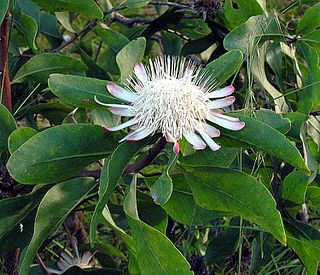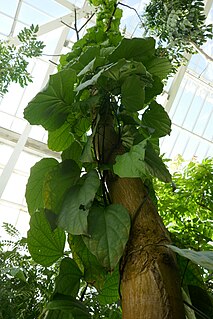
Violaceae is a family of flowering plants established in 1802, consisting of about 1000 species in about 25 genera. It takes its name from the genus Viola, the violets and pansies.

Friedrich Martin Josef Welwitsch was an Austrian explorer and botanist who in Angola discovered the plant Welwitschia mirabilis. His report received wide attention among the botanists and general public, comparable only to the discovery of two other plants in the 19th century, namely Victoria amazonica and Rafflesia arnoldii.

Protea gaguedi is a species of tree which belongs to the genus Protea.

Protea welwitschii is a species of shrub or small tree which belongs to the genus Protea, and which occurs in bushveld and different types of grassland.

Welwitsch's bat also known as Welwitsch's mouse-eared bat or Welwitsch's myotis is a species of vesper bat native to Africa.

Rinorea is a genus of plant in family Violaceae.
Rinorea cordata is a species of plant in the Violaceae family. It is endemic to Colombia.
Rinorea crenata is a species of plant in the Violaceae family. It is found in Costa Rica and Panama.
Rinorea dasyadena is a species of plant in the Violaceae family. It is found in Colombia, Costa Rica, and Panama.
Rinorea endotricha is a species of plant in the Violaceae family. It is found in Guyana and Venezuela.
Rinorea hirsuta is a species of plant in the Violaceae family. It is found in Colombia and Panama.
Rinorea keayi is a species of plant in the Violaceae family. It is found in Cameroon and Nigeria. It is threatened by habitat loss.
Rinorea squamata is a species of plant in the Violaceae family. It is found in Costa Rica, Honduras, Nicaragua, and Panama.
Utricularia welwitschii is a small to medium-sized, probably perennial, carnivorous plant that belongs to the genus Utricularia. It is endemic to tropical Africa, where it can be found in the Democratic Republic of the Congo, Madagascar, Malawi, South Africa, Tanzania, Zambia, and Zimbabwe. U. welwitschii grows as a terrestrial plant in sandy or peaty soils in marshy grasslands at altitudes from 1,000 m (3,281 ft) to 2,200 m (7,218 ft). It was originally described and published by Daniel Oliver in 1865. Taylor previously described two varieties of U. welwitschii, U. welwitschii var. odontosepala and U. welwitschii var. microcalyx, in 1964, but later elevated them to the rank of species as U. odontosepala and U. microcalyx, respectively. It is named in honor of Friedrich Welwitsch.

Alpinumisoflavone is a pyranoisoflavone, a type of isoflavone. It can be found in the bark of Rinorea welwitschii. It can also be found in the molluscicide plant Millettia thonningii and is thought to be an antischistosomal agent since it has been shown to kill the snails which transmit the schistosomiasis and also the larvae of the parasite itself.

Rinorea bengalensis is a species of plant in the family Violaceae. They are seen as understorey trees in wet evergreen forests up to 800 meters in Indomalaysia, Australia and Pacific Islands and in the Western Ghats they can be seen at Coorg and Chikmagalur Regions.

Lannea welwitschii is a species of tree in the family Anacardiaceae. It is native to the tropical rainforests of West and Central Africa. The timber is used to make furniture and utensils and for many other purposes, the fruits can be eaten, and the bark is used to produce a dye, for making rope and in traditional medicine.
Securidaca welwitschii is a species of plant in the family Polygalaceae. It is endemic to Angola, Benin, Burundi, Cameroon, Congo, Gabon, Guinea, Ivory Coast, Kenya, Liberia, Nigeria, Rwanda, Sierra Leone, Sudan, Tanzania, Uganda, Zambia, and the Democratic Republic of the Congo.

Olea welwitschii, the Elgon teak, is a species of tree in the family Oleaceae. It ranges across parts of subsaharan Africa, from Cameroon in the west to Ethiopia and Kenya in the east, and south to Angola, Zambia, and Mozambique. It is a forest species, ranging from lowland tropical rainforests to evergreen montane forests.









